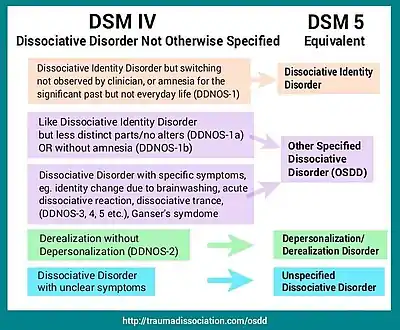Dissociative disorder not otherwise specified
Dissociative disorder not otherwise specified (DDNOS) was a mental health diagnosis for pathological dissociation that matched the DSM-IV criteria for a dissociative disorder, but did not fit the full criteria for any of the specifically identified subtypes, and the reasons why the previous diagnoses were not met are specified. The International Statistical Classification of Diseases and Related Health Problems (ICD-10) refers to the diagnosis as "Other dissociative and conversion disorders".[1] Under the fifth edition of the Diagnostic and Statistical Manual of Mental Disorders (DSM), it is known as "Other specified dissociative disorder" (OSDD).

Dissociative Disorders from DSM-IV to DSM-V
| Dissociative disorder not otherwise specified | |
|---|---|
| Other names | Other dissociative and conversion disorders, partial dissociative identity disorder |
| Specialty | Psychiatry |
| Differential diagnosis | Dissociative identity disorder, Depersonalization-derealization disorder, borderline personality disorder, post-traumatic stress disorder, unspecified dissociative disorder |
DDNOS diagnoses
Under DDNOS, there were a number of dissociative conditions.
- DDNOS 1 - DID but switching not observed by clinician, or amnesia for the significant past but not everyday life.[2]
- DDNOS 1a - Like DID but with less distinct parts/no alters. Alters may be emotional fragments or the same individual at different ages. Can experience emotional amnesia rather than physical amnesia.[2][3]
- DDNOS 1b - Like DID but no amnesia between alters.[2][3]
- DDNOS 2 - Derealization without Depersonalization.[2]
- DDNOS 3,4,5,etc. - DID but with specific symptoms. Eg) Identity change due to brainwashing, acute dissociative reaction, dissociative trance, Ganser Syndrome.[2]
- Dissociative Disorder with Unclear Symptoms.[2]
See also
References
- International Statistical Classification of Diseases and Related Health Problems, 10th Revision (2017). F44.89.
- traumadissociation.com (2015). "Other Specified Dissociative Disorder (DDNOS) - Types and DSM 5 criteria". Trauma dissociation. Retrieved 2020-07-29.
- "Comparing OSDD-1 and DID". did-research.org. Retrieved 2020-07-29.
This article is issued from Wikipedia. The text is licensed under Creative Commons - Attribution - Sharealike. Additional terms may apply for the media files.